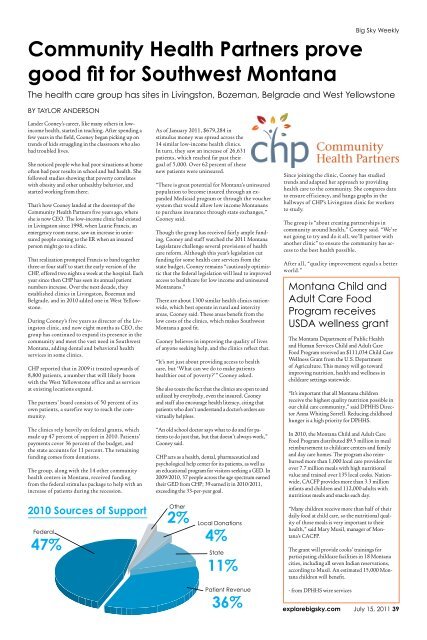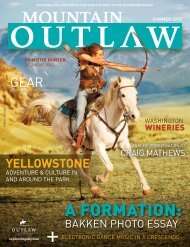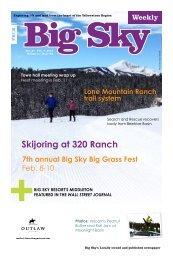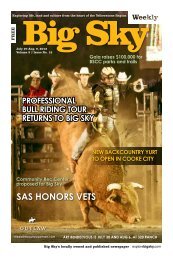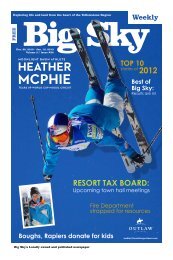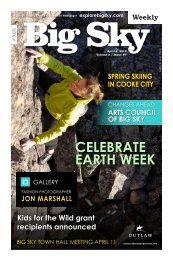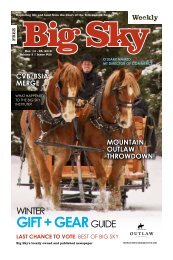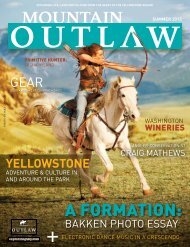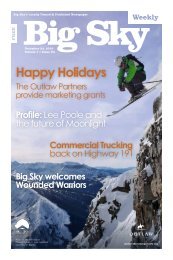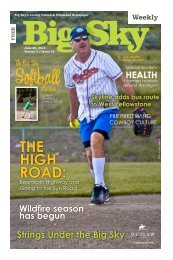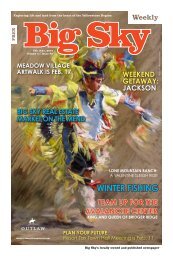health + wellness - Explore Big Sky
health + wellness - Explore Big Sky
health + wellness - Explore Big Sky
Create successful ePaper yourself
Turn your PDF publications into a flip-book with our unique Google optimized e-Paper software.
community <strong>health</strong> Partners prove<br />
good fit for southwest Montana<br />
Lander Cooney’s career, like many others in lowincome<br />
<strong>health</strong>, started in teaching. After spending a<br />
few years in the field, Cooney began picking up on<br />
trends of kids struggling in the classroom who also<br />
had troubled lives.<br />
She noticed people who had poor situations at home<br />
often had poor results in school and bad <strong>health</strong>. She<br />
followed studies showing that poverty correlates<br />
with obesity and other un<strong>health</strong>y behavior, and<br />
started working from there.<br />
That’s how Cooney landed at the doorstep of the<br />
Community Health Partners five years ago, where<br />
she is now CEO. The low-income clinic had existed<br />
in Livingston since 1998, when Laurie Francis, an<br />
emergency room nurse, saw an increase in uninsured<br />
people coming to the ER when an insured<br />
person might go to a clinic.<br />
That realization prompted Francis to band together<br />
three or four staff to start the early version of the<br />
CHP, offered two nights a week at the hospital. Each<br />
year since then CHP has seen its annual patient<br />
numbers increase. Over the next decade, they<br />
established clinics in Livingston, Bozeman and<br />
Belgrade, and in 2010 added one in West Yellowstone.<br />
During Cooney’s five years as director of the Livingston<br />
clinic, and now eight months as CEO, the<br />
group has continued to expand its presence in the<br />
community and meet the vast need in Southwest<br />
Montana, adding dental and behavioral <strong>health</strong><br />
services in some clinics.<br />
CHP reported that in 2009 it treated upwards of<br />
8,800 patients, a number that will likely boom<br />
with the West Yellowstone office and as services<br />
at existing locations expand.<br />
The partners’ board consists of 50 percent of its<br />
own patients, a surefire way to reach the community.<br />
The clinics rely heavily on federal grants, which<br />
made up 47 percent of support in 2010. Patients’<br />
payments cover 36 percent of the budget, and<br />
the state accounts for 11 percent. The remaining<br />
funding comes from donations.<br />
The group, along with the 14 other community<br />
<strong>health</strong> centers in Montana, received funding<br />
from the federal stimulus package to help with an<br />
increase of patients during the recession.<br />
As of January 2011, $679,284 in<br />
stimulus money was spread across the<br />
14 similar low-income <strong>health</strong> clinics.<br />
In turn, they saw an increase of 26,631<br />
patients, which reached far past their<br />
goal of 5,000. Over 62 percent of these<br />
new patients were uninsured.<br />
“There is great potential for Montana’s uninsured<br />
population to become insured through an expanded<br />
Medicaid program or through the voucher<br />
system that would allow low income Montanans<br />
to purchase insurance through state exchanges,”<br />
Cooney said.<br />
Though the group has received fairly ample funding,<br />
Cooney and staff watched the 2011 Montana<br />
Legislature challenge several provisions of <strong>health</strong><br />
care reform. Although this year’s legislation cut<br />
funding for some <strong>health</strong> care services from the<br />
state budget, Cooney remains “cautiously optimistic<br />
that the federal legislation will lead to improved<br />
access to <strong>health</strong>care for low income and uninsured<br />
Montanans.”<br />
There are about 1300 similar <strong>health</strong> clinics nationwide,<br />
which best operate in rural and intercity<br />
areas, Cooney said. These areas benefit from the<br />
low costs of the clinics, which makes Southwest<br />
Montana a good fit.<br />
Cooney believes in improving the quality of lives<br />
of anyone seeking help, and the clinics reflect that.<br />
“It’s not just about providing access to <strong>health</strong><br />
care, but ‘What can we do to make patients<br />
<strong>health</strong>ier out of poverty?’” Cooney asked.<br />
She also touts the fact that the clinics are open to and<br />
utilized by everybody, even the insured. Cooney<br />
and staff also encourage <strong>health</strong> literacy, citing that<br />
patients who don’t understand a doctor’s orders are<br />
virtually helpless.<br />
“An old school doctor says what to do and for patients<br />
to do just that, but that doesn’t always work,”<br />
Cooney said.<br />
CHP acts as a <strong>health</strong>, dental, pharmaceutical and<br />
psychological help center for its patients, as well as<br />
an educational program for visitors seeking a GED. In<br />
2009/2010, 37 people across the age spectrum earned<br />
their GED from CHP; 39 earned it in 2010/2011,<br />
exceeding the 33-per-year goal.<br />
explorebigsky.com<br />
big sky weekly<br />
the <strong>health</strong> care group has sites in livingston, bozeman, belgrade and west yellowstone<br />
by taylor anderson<br />
2010 sources of support<br />
Federal<br />
47%<br />
other<br />
2%<br />
local donations<br />
4%<br />
state<br />
11%<br />
patient revenue<br />
36%<br />
Since joining the clinic, Cooney has studied<br />
trends and adapted her approach to providing<br />
<strong>health</strong> care to the community. She compares data<br />
to ensure efficiency, and hangs graphs in the<br />
hallways of CHP’s Livingston clinic for workers<br />
to study.<br />
The group is “about creating partnerships in<br />
community around <strong>health</strong>,” Cooney said. “We’re<br />
not going to try and do it all, we’ll partner with<br />
another clinic” to ensure the community has access<br />
to the best <strong>health</strong> possible.<br />
After all, “quality improvement equals a better<br />
world.”<br />
Montana Child and<br />
adult Care Food<br />
program receives<br />
usda <strong>wellness</strong> grant<br />
The Montana Department of Public Health<br />
and Human Services Child and Adult Care<br />
Food Program received an $111,034 Child Care<br />
Wellness Grant from the U.S. Department<br />
of Agriculture. This money will go toward<br />
improving nutrition, <strong>health</strong> and <strong>wellness</strong> in<br />
childcare settings statewide.<br />
“It’s important that all Montana children<br />
receive the highest quality nutrition possible in<br />
our child care community,” said DPHHS Director<br />
Anna Whiting Sorrell. Reducing childhood<br />
hunger is a high priority for DPHHS.<br />
In 2010, the Montana Child and Adult Care<br />
Food Program distributed $9.5 million in meal<br />
reimbursement to childcare centers and family<br />
and day care homes. The program also reimbursed<br />
more than 1,000 local care providers for<br />
over 7.7 million meals with high nutritional<br />
value and trained over 135 local cooks. Nationwide,<br />
CACFP provides more than 3.3 million<br />
infants and children and 112,000 adults with<br />
nutritious meals and snacks each day.<br />
“Many children receive more than half of their<br />
daily food at child care, so the nutritional quality<br />
of those meals is very important to their<br />
<strong>health</strong>,” said Mary Musil, manager of Montana’s<br />
CACFP.<br />
The grant will provide cooks’ trainings for<br />
participating childcare facilities in 18 Montana<br />
cities, including all seven Indian reservations,<br />
according to Musil. An estimated 15,000 Montana<br />
children will benefit.<br />
- from DPHHS wire services<br />
July 15, 2011 39


